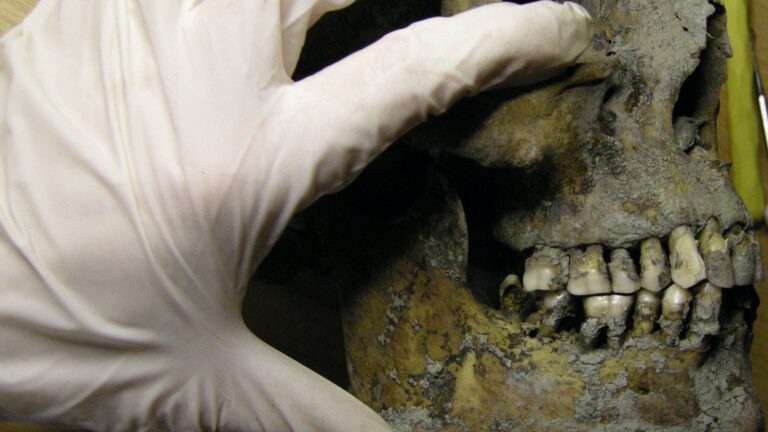At the height of the Viking Age, seafaring Norse warriors ruled northern Europe and beyond. However, even when they terrorized, say, the British Isles, they lost the battle against oral bacteria. As it turns out, many Vikings suffered from tooth decay, plaque build-up and tooth infections and used various strategies to reduce the pain.
Several studies have looked at the dental health of the Vikings, including one published in December 2023 in journal PLOS One. For this study, a research team examined the skeletal remains of 171 Vikings buried outside from the 10th to 12th centuries. Varnhem Abbeythe site of the oldest stone church in Sweden.
Lead author Carolina Bertilsson, a practicing dentist and research associate at the University of Gothenburg, essentially gave each set of Viking teeth a routine check-up. She and two dental students used a bright light, a round dental mirror and a soft toothbrush to inspect a total of 3,293 teeth and then X-rayed some of them to confirm their findings.
Among the Viking children, they could not detect a single cavity, a far cry from today, where even in Sweden—which Bertilsson calls “one of the countries in the world with the best dental health”—about 20 percent of 6 years—old people have already developed a cavity. (THE percentage is much higher in the United States.)
For adult Vikings, however, it was a different story. More than 60 percent of people tested had at least one cavity, and one person was found to have 22 huge cavities. Bertilsson and her colleagues also found evidence of plaque and calculus buildup, as well as infections that would cause painful, pus-filled tooth abscesses. “You can see the tracks [of these things] even 1,000 years later,” says Bertilsson.
A Viking woman in her thirties had a tooth infection so severe it may have killed her, either by blocking her airways or causing sepsis. “Even today, it’s a serious situation,” says Bertilsson. “You have to use antibiotics. Sometimes you need to go to the hospital to get treatment.”
The Viking diet was tough on dental hygiene
What caused all these dental problems? The Viking diet may be to blame. Medieval Scandinavians ate meat, fish, dairy, vegetables and hazelnuts, all generally good for oral health. But they also dined on starchy and sweet foods such as bread, porridge, honey and fruit, and drank beer and mead, which over time can cause chronic dental disease.
Previous research suggests that other Viking communities, including Denmark, Scotland and the Swedish island of Gotland, also suffered from cavities. The Icelandic Vikings, on the other hand, seem to have developed relatively few cavities (although they experienced extensive tooth wear), possibly because they did not eat as much starch and natural sugar as their less isolated counterparts.
The Vikings, known for their excellent hygiene, did not take these problems lying down. Bertilsson’s team found evidence that they pulled out rotten teeth and also used toothpicks—a practice that dates back back to Neanderthals— to remove bits of stuck-on food. Most surprisingly, Bertilsson’s team found two instances in which Vikings apparently dug into the pulp chamber of a tooth, possibly to relieve the pain of an infection.
“Obviously, they didn’t have anesthetics, so it must have hurt a lot,” says Bertilsson, who adds that the Vikings were not known to have done such a procedure before.
(Although not related to dental health, some male Vikings also filed grooves on their front teeth, possibly as a status or fashion symbol.)
Medieval Europe: A ‘Bad Age for Teeth’
The Vikings were certainly not unique among medieval Europeans when it came to dental problems. “It’s a really bad time for teeth,” Sarah A. Lacy, an assistant professor of anthropology at the University of Delaware who studies ancient teeth, says of the Middle Ages. In fact, he says that people’s oral health first began to deteriorate about 20,000 years ago, at the height of the last Ice Age, when shrinking habitable land caused dietary changes. Primitive dentistry followed not long after. already 13,000 years ago, dental resin fillings used in Italy.
Because of their diet, hunter-gatherers they generally had healthy chompers (although there were exceptions, such as a Paleolithic group in present-day Morocco with a love for sweet acorns). But when societies transitioned to agriculture, their teeth usually suffered and they began to look for additional ways to treat them. For example, scientists discovered that flint tools were supposedly used to drill inside molars damaged by cavity in Pakistan about 7,500 to 9,000 years ago, while a 6,500-year-old dental sealing with beeswax discovered in Slovenia.
Meanwhile, the ancient Mesopotamians (wrongly) blamed tooth worms for tooth decay, the ancient Egyptians and others used toothpaste, the ancient Etruscans made gold crowns and dental bridges, and the Chinese invented the bristle toothbrush. However, modern dentistry only dates back to the 18th century, around the time the Industrial Revolution ushered in an era of refined flour and sugar wreaking havoc on people’s teeth. Until recently, Lacy says, oral health “just kept going up and down over time.”
Indeed, despite the lack of fluoridated toothpaste, toothbrushes, floss, and professional dentistry, the dental health of the Vikings, especially for children, somehow surpassed that of 21st century humans.



